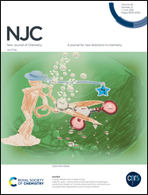Melanin nanoparticles as an actinide in vivo sequestration agent with radiation protection effect†
Abstract
Internal contamination of actinides has been a long term concern for the medical treatment of people in nuclear accident scenarios, due primarily to their chemo- and radio-toxicity. So far, many ligands and functional nanomaterials have been designed to sequester actinides in vivo, however, little attention has been paid to reduce the injury induced by the internal exposure of actinides. Herein, we propose PEG grafted melanin nanoparticles (MNPs-PEG) as a bifunctional agent that can not only selectively sequester two different actinides (namely U and Th) at the same time, but also reduce the reactive oxygen species (ROS) level in U and Th contaminated cells. The adsorption experiments indicate that more than 99% of U and Th can be chelated selectively by MNPs-PEG in the presence of excess interfering ions. The in vitro decorporation assays show that the material can greatly reduce the deposition of U (77.5%) in NRK-52E cells and Th (75.8%) in AML-12 cells. In addition, ROS assays show that MNPs-PEG can almost reduce the intracellular ROS to a normal level, verifying its remarkable radical quenching ability. More importantly, an in vivo study demonstrated the effective sequestration capability of MNPs-PEG by reducing 33.1% and 45.4% of U from kidneys and bones, respectively, and 42.8% of Th from the liver of mice, simultaneously. Our results show that the MNPs-PEG exhibit clear advantages compared with the current decorporation agents in both actinide sequestration and radiation protection capabilities.



 Please wait while we load your content...
Please wait while we load your content...